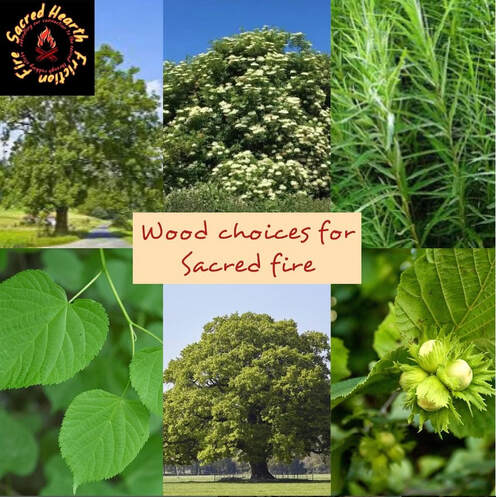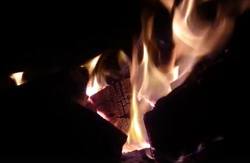 Wood choices for sacred fire… I don’t mandate any particular wood - what is important for me personally is:
1-it’s native to where I am 2- preferably it’s sourced local to where I am welcoming fire (if at all possible) 3-it’s been collected from fallen/dead standing wood or it’s overly abundant and has been harvested sustainably My preferred wood for bow drill in ritual is English Oak which has been collected from wind fallen branches. Hazel is my favourite tree and loves having fire coaxed from her and commonly sheds branches. For sacred/ritual practice I collect my wood in advance and season There are lots of combinations for bow drill and it can be a personal choice.I also make my own cordage usually from nettles With Neid Fire I am working on a larger scale and so I am reliant on what I can find which has naturally fallen - I have Hazel and Ash spindles and Hazel and Poplar hearth logs and Holly for the bearing log. I kept/keep scouring the woods to find suitable fallen branches/trees.And for Neid Fire you need to collect in advance and season Traditionally Oak was used for Neid fire but it is very difficult to find suitable fallen oak and I would NEVER cut a live Oak for my own purposes and I DO NOT advocate cutting live Oak. For the fire wood - for me it is importent that it is native, local (if poss) and collected from fallen wood and is a good burning wood and is dry - I commonly use hazel and/or birch first (fast burning) then ash or seasoned oak. Again I collect in advance and season. (These woods are all native and local to me) The sourcing, collecting and preparing the wood is a huge part of my friction fire practice which I endeavour to do with awareness and respect and gratitude -for neid fire it can take several months I’m blessed in that I live next to woods with Hazel, Oak, Elder, Ash, Hawthorn, Elm, Poplar, Willow, Tilia, Ivy, Clematis There is a perception that friction fire prefers dry conditions. Admittedly it is far easier in dry conditions and not all woods like dampness and I can't use the hand drill with damp wood and I'd prefer the dry any day! However, It can be possible with some wood species which are damp using the bow drill. I'm not saying you can do it with soaking wet, soggy all the way through wood but it can sometimes be possible with damp wood as I've tested recently. Of course, if it's chucking it down with rain you need to get into a sheltered spot and of course you need dry tinder and wood. Personally I prefer to carry everything I need with me but if you have the knowledge, it can be possible but a bit more prep may be needed (e.g. making feather sticks etc, using tinder fungus.) It's best to try and find dead standing wood with bark on as rain runs off it and it doesn't get as wet as wood on the ground or horizontal wood.
As an experiment I soaked a freshly made hazel drill (without bark) and an Ash hearthboard in water for over half an hour then I made a fresh hole and attempted to tempt an ember out. I had wiped off the excess water first and the wood was still damp, however the friction dried out the wood and I was able to tempt out an ember. It took a little bit longer than with dry wood, and the drill did slip a bit at first. The top of the spindle did suffer a bit and bits broke off due to the moisture but the bottom end worked well. Of course, out in the woods, it'll more difficult especially if raining as you'll need to try and be sheltered and keep your hands and your kit dry etc and you'll want to try and place the hearth on something dryish and try not to drip all over it! The wood also needs to be suitable. e.g right deadness, not green. And some woods ay not work in the damp. A wood like ivy may bot work as that soaks up moisture but woods like dead standing hazel ashould hopefully work in the wilds.  So my focus is more on friction fire (and stories\rituals\sacredness etc) than bushcraft but I thought I would write a bit on firewood, as once you've tempted that ember out of the wood, you need to be able to feed that ember and feed the fire. It is good to understand the properties of wood and which ones are good for burning, especially outdoors in the wild (which is slightly different to home especially if you use a wood burner.) The best kindling wood, is wood which burns easily and fast, and best fire wood is wood which is usually denser, burns more slowly, doesn’t spark\smoke and gives good heat output. Here are a few different types of wood you may find in UK woodlands, and burning properties. And of course woods burn best when dry, have had chance to season (not green) and not punky (however very dry punky wood can be good for tinder.) Look for dead standing (vertical) wood, as it will be drier (water runs off it), or wood which has been off the ground. Wood on the ground will be damper. Also, just because a wood is good for creating embers through friction it doesn’t mean it’s a good burning wood! Typically the best woods for friction fire are poor for burning and good burning woods are poor for friction - with exceptions e.g. Hazel and Ash work for both.. Also, it's essential to know your trees (a good pocket guide is very useful.) Kindling: Wood which burns easily and quickly is best for kindling and should be split very thin to start then add increasingly bigger pieces until fire is burning well. E.g. Hazel, Ash, Beech, Hazel, Hawthorn. Pine works well too for kindling. I usually use the tipi fire lay method. Firewood: Split wood usually burns better than big logs, and start with smaller (in thickness) sized pieces and gradually add bigger pieces. Recommended for open fires: Ash: Reckoned by many to be one of best woods for burning. It produces a steady flame and good heat output. It can be burnt when still green but like all woods, it burns best when dry. (Ash also works well for friction hearth boards.) Hazel: Is a good fast burning wood with little spitting and good for starting your fire. (Hazel is my favourite for friction spindles and also hearth boards when used with itself.) Hawthorn: Is a good traditional firewood that has a slow burn with good heat output and little smoke. (Good for bearing blocks as very hard.) Blackthorn: Another good wood. Burns slowly with lots of heat and little smoke. (Good for bearing blocks as very hard.) Beech: Burns very much like ash, but does not burn well when green. Has a tendency to spark. Hornbeam: A good burning wood that burns similar to beech, slow burn with a good heat output. Yew: A good burning wood as it has a slow burn, and produces a very good heat output. Rowan: A good burning wood as it has a slow burn, and produces a very good heat output. Some people prefer not to burn Rowan due to personal beliefs (it being seen as a sacred wood.) Birch: Is a very good burning wood although burns fairly fast. Mix with slower burning woods Not really reccomended for open fires Oak: Good firewood for home when seasoned but can be poor for outdoor fires. Because of its density, oak produces a small flame and very slow burn, it is best when seasoned for a minimum of two years as it is a wood that requires time to season well (so may be hard to find good well seasoned dry oak in the wild!) Due to it’s sacredness Oak tended to be used in ritual\ceremonial fires within the UK. Sycamore: Produces a good flame, but with only moderate heat output. Should only be used well-seasoned. (Good for friction fire – it’s one I’ve not tried yet) Pine - Burns well but tends to spit. The resinous wood makes good kindling so better for kindling rather than firewood. (works for friction fire – another one I’ve not tried yet) Ivy – dry and well seasoned it is supposed to burn well according to some, but in the wild can be difficult finding dry well seasoned ivy. Very good for friction hearth boards. Alder: Produces poor heat output and it does not last well. Douglas fir: Not very good. Produces little flame or heat. Poplar: A very smokey wood with a poor burn. Good for friction fire (one I’ve not tried yet.) Willow: A poor fire wood that does not burn well even when seasoned. Good for for friction hearth boards and spindles. Larch: Needs to be seasoned well. Spits excessively while it burns. Elder: Burns quickly with little heat. Very smokey. (Very good for hand drill spindles)
Elm: Typically poor for open fires as it needs to have been seasoned for a couple of years and is slow to get going Holly: Is a fast burning wood that produces good flame but poor heat output. Holly will burn green, but best dried for a minimum of a year. Horse&Sweet Chestnut: A good wood for burning in wood stoves but not for open fires as it does tend to spit a lot. It does however produce a good flame and heat output. Spruce - Burns very quickly and sparks badly. Laurel: Said to be good firewood but best stay away from Cherry Laurel as leves contains cyanide. Conflicting opinions on whether you can burn it – some say if split and well seasoned then apparently you are ok. Seen other stories of people getting headaches from it. I would say stay away from it – there’s plenty of other wood Lime: Not a good wood for burning as it produces very little flame or heat output. Very good for friction hearth boards. |
Archives
January 2024
Categories
All
|




 RSS Feed
RSS Feed